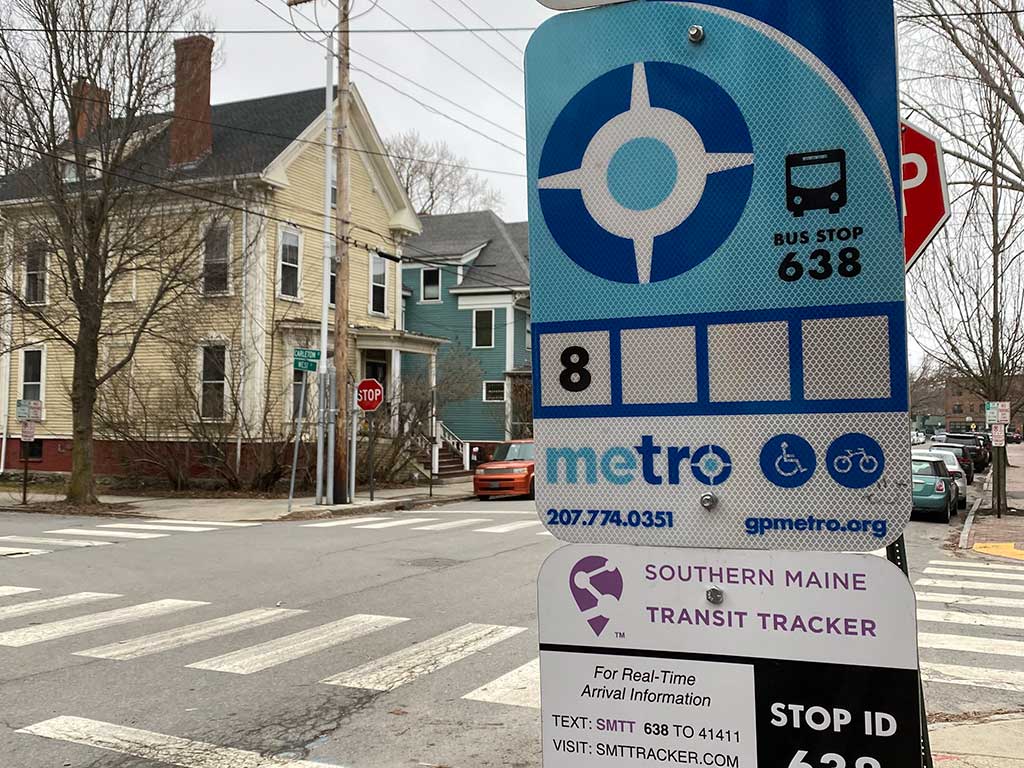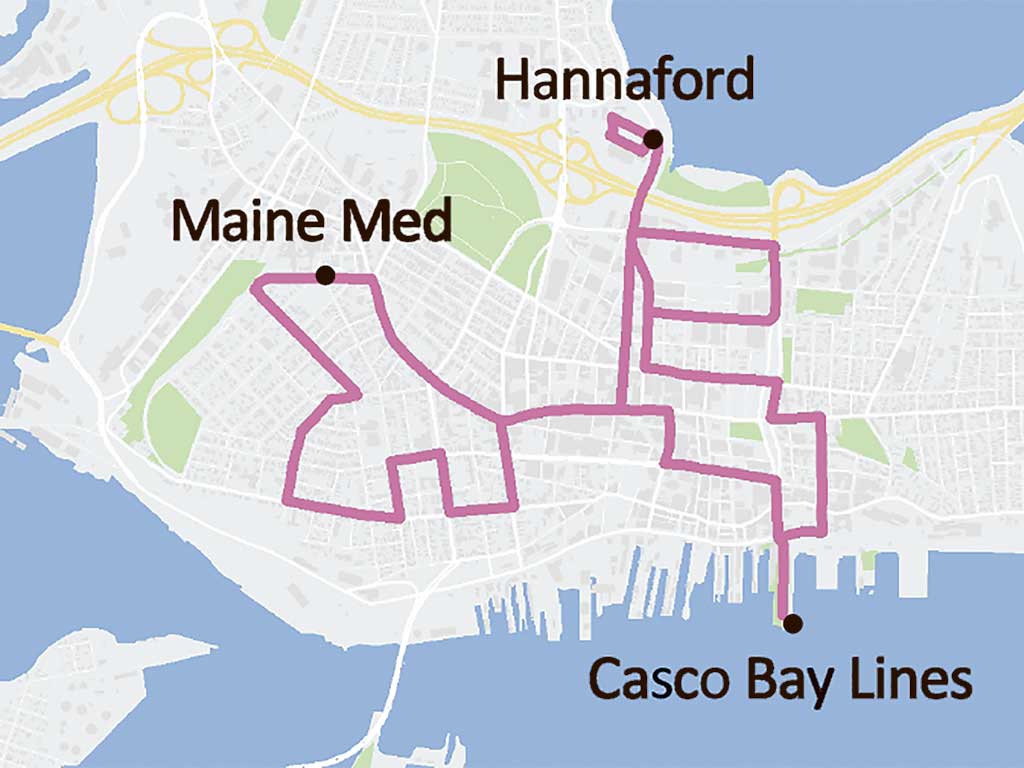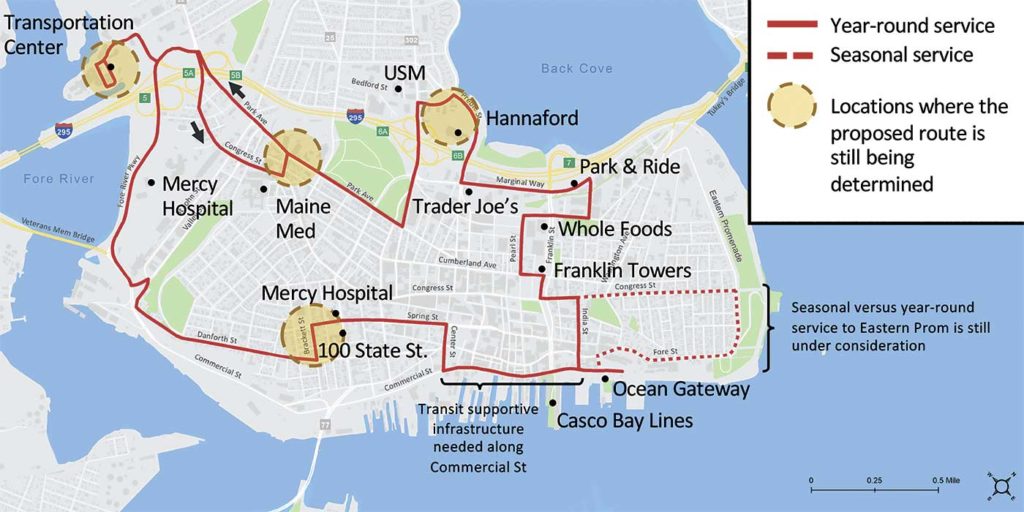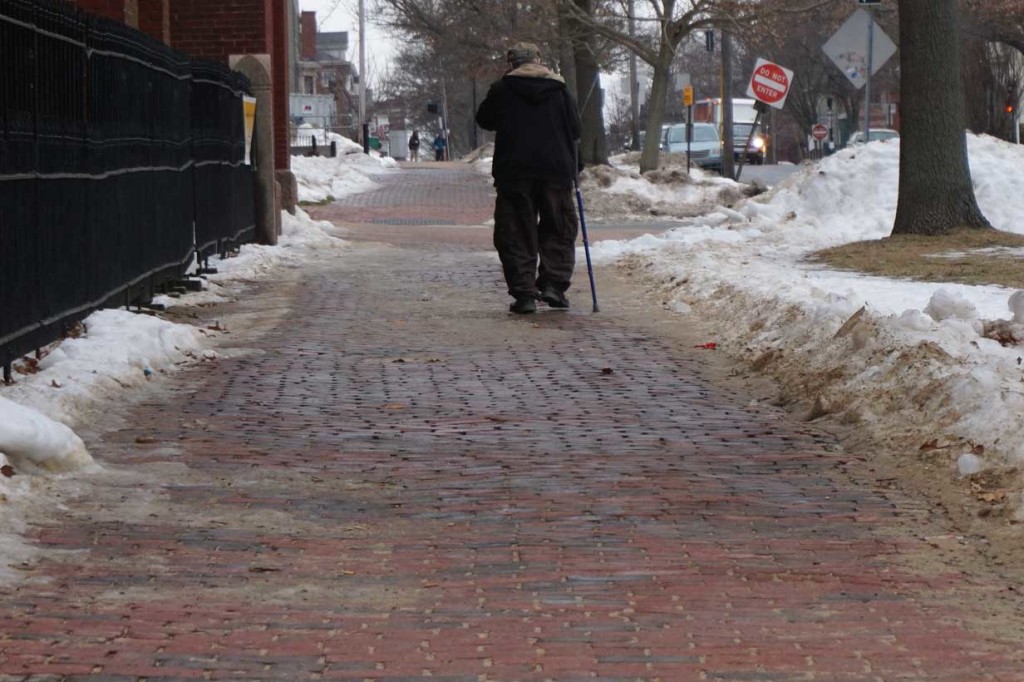By Tony Zeli
The Greater Portland Metro is updating its bus routes and proposing a new bi-directional circulator route for the Portland peninsula. The goal is faster service and greater frequency, but the new route eliminates stops in the West End neighborhood. As such, Metro and the West End Neighborhood Association (WENA) are coordinating to hold a West End listening session.

The proposed new Portland peninsula circulator would replace the current Routes 1 and 8. It travels a loop around the peninsula instead of through it. Additionally, Metro staff have recommended more minor route changes for the 2, 4, 5, 7, and the Husky Line. This includes routing the #5 bus (covering the mall and jetport) to also cover Munjoy Hill, offsetting the loss of Route 1.
West End residents will be the most impacted by the route changes in that they will lose the most stops. Aging and disabled residents of the neighborhood’s assisted living facilities will lose door to door service from their homes to where they buy their groceries, receive medical care, and enjoy the city’s cultural and civic life.
ROUTE 8

Metro Route 8 draws a circuitous route from downtown and the Metro Pulse through the heart of the West End. It travels to the waterfront and Casco Bay Lines, and then to the East End. Route 8 makes a direct stop at the Back Cove Hannaford. It also travels along Congress Street passing Reny’s, the public library, CVS, and Portland City Hall. In addition, Route 8 makes its way directly to low-income and senior housing, including large residences at 75 and 100 State Street.
The problem with Route 8, if there is one, is that it runs in one direction, according to Kim Sutton, WENA President.
When Metro asked West End residents what they wanted to improve about the #8, they wanted to increase frequency and make the route bi-directional.
“For example, from 77 Pine to Hannaford takes 45 minutes, but from Hannaford back to Pine is fast – about 15 minutes,” noted Sutton in an email to The West End News.
PROPOSED PENINSULA CIRCULATOR

Metro describes the proposed route as an “urban circulator.”
It would loop in both directions around the Portland peninsula, instead of through it. The goal is to provide faster service with more frequency. Hopefully, a bus every fifteen minutes that connects everything from the Ocean Gateway to the transportation center.
“It’s a bit unclear to me why this is going on,” said James Fereira, a Route 8 rider and former contributor to The West End News. “It wasn’t broken in my mind in the first place.”
Semi-retired, Fereira uses Route 8 primarily for food shopping. Every few weeks Fereira will walk down to Hannaford at Back Cove and get his staple goods. Once done, arms full of groceries, he’ll grab the #8, which stops directly at Hannaford. Ten minutes or so later, the bus drops him off a half block from home on West Street.
“Right now, the bus stops right at the store,” Fereira said. “The new route is moved to the periphery where people will have to haul their bags.” And he noted, by traveling around the peninsula along West Commercial Street, the circulator no longer goes where people live.
“I wonder if by moving it to the periphery they aren’t making it more appealing to visitors of the city rather than local people who live here,” said Fereira.
The circulator would also cut out senior and disabled housing, including 75 State Street, 100 State Street, and 77 Pine Street. These residents will now have an uphill climb to the bus stop.
WENA President Kim Sutton noted that the circulator won’t solve the issue of faster service, especially for certain popular trips like going to the supermarket, because “although it is more frequent (every 15 minutes instead of every 30 minutes) riders would have an extra 15-minute walk to the new stops.”
“In an ideal world, we would have both the circulator and the #8, and not have an either-or situation,” wrote Sutton.
So, how did this all come about?
In fall 2019, Metro held public meetings to gather feedback on current bus routes. Despite having reached record numbers, with riders taking over 2.1 million trips that year, Metro saw room for improvement.
To summarize the feedback, riders wanted buses to run more often, for longer hours, with more direct routes. Metro’s response was to propose the Portland Circulator, eliminate Routes 1 and 8, and make tweaks to other routes.
Impact on West End Residents

After creating the proposed circulator, Metro went to the public. They held two Zoom meetings on the proposed route changes. One was in the morning and another in the evening of Tuesday, December 8th, 2020. Given the impact on residents at 75 and 100 State Street, Metro held a Zoom listening session specifically for them on March 3rd, 2021.
Gwynne Williams, a WENA board member, attended the meeting by phone because the Zoom link did not work. “People were quite upset and almost despairing at the prospect of the loss of their stops, and the unmanageable distance they would have to traverse including the need to try to navigate in the streets for so many stretches of often un-shoveled sidewalks,” said Williams.
“There was also considerable distress about the route no longer going down Congress Street, so losing access to the pharmacy and library there, and of course the bus no longer going into the Hannaford lot and stopping at their door.”
Greater Portland Metro General Manager Greg Jordan described a robust public outreach effort in an email response to the News.
“Metro has held numerous public and stakeholder meetings on this topic since December, most recently with residents of 100 State Street and 77 Pine Street. Overall attendance at all our public/group meetings totals nearly 300 and we’ve documented extensive comments. We’ve distributed information to 700 individuals and groups. We’ve received 125 responses to our survey effort. Metro’s outreach on this project has been extensive and, based on the feedback received, we have a good understanding of where the core concerns are,” Jordan wrote.
Opportunity for Feedback on Peninsula Circulator
WENA is working with Metro to arrange additional opportunity for West End residents to share their concerns. This will be the last chance for feedback from riders and other stakeholders.
“We will be coordinating with the West End Neighborhood Association on this, though we do not yet have a firm date(s) or venues set up for this yet,” Jordan wrote.
In late April and May there will be another round of public review with a goal of presenting a final set of route proposals to GP Metro Board of Directors. The directors include public officials and stakeholder representatives from the towns covered by Metro.
If approved and funded, these service changes would launch in late 2022.
Tony Zeli is publisher and editor. Reach him at thewestendnews@gmail.com. The West End News is an independent community newspaper and is not affiliated with the West End Neighborhood Association.





